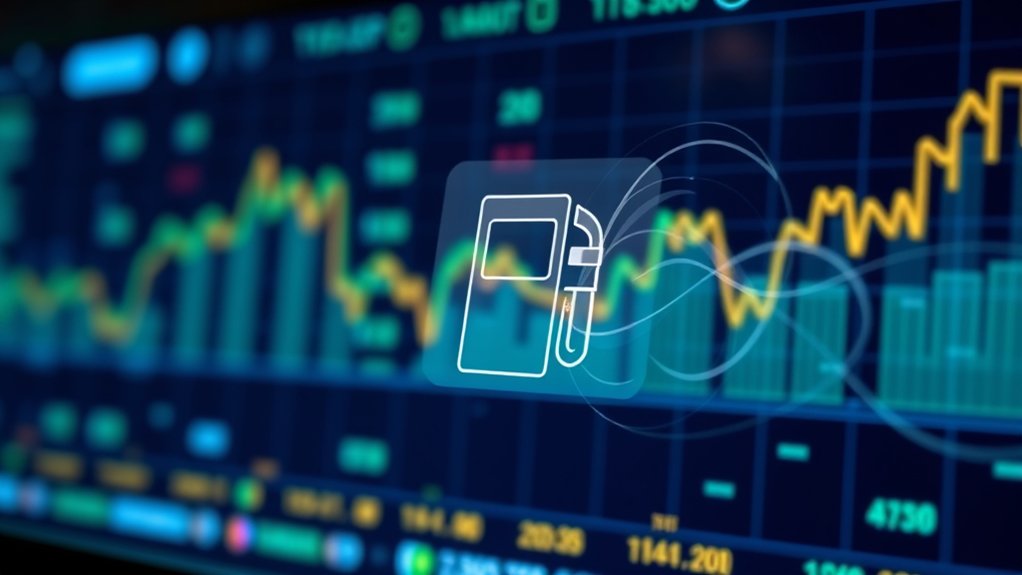Gas fees are like the tolls for using the Ethereum highway. They vary based on demand, with chaotic spikes during busy times—think NFT launches. The fees consist of a base fee, which fluctuates, and a priority fee to get your transaction pushed ahead. It’s a wild system, often frustrating, as costs can soar unexpectedly. Maneuvering through these fees? You’ll need to be savvy. Stick around, and you’ll find more on how to manage this madness.

Understanding crypto gas fees is like trying to decipher the latest trend in fashion—confusing, frustrating, and sometimes downright ridiculous. At its core, gas fees are the transaction costs on blockchain networks, mainly Ethereum. They’re what keeps the blockchain running smoothly, compensating validators for their computational work. Without gas fees, the whole system would collapse. Simple, right? Not so fast.
Gas fees have evolved. They used to be calculated using just gas limits and gas prices. Now, thanks to Ethereum’s London Upgrade, we’ve added a base fee and a priority fee into the mix. The base fee is set dynamically, fluctuating with network demand. When everyone and their dog wants to make a transaction at once, guess what? Fees shoot up. It’s like trying to grab a last-minute ticket to a sold-out concert—prepare to pay through the nose. This surge in fees can often be attributed to network congestion, where the number of transactions exceeds the network’s processing capacity.
The components of gas fees are like the ingredients in a bad recipe. You’ve got the gas limit, which is your cap on how much effort you’re willing to expend. The gas price? That’s changed over time; it used to be straightforward but is now a tangled mess of economics. And don’t forget about Gwei, the tiny unit used to express these prices. It’s all interconnected, and when one part goes haywire, the whole system feels it. Additionally, gas fees are essential for maintaining network operations and incentivizing validators for their resources used in transaction processing.
Factors influencing gas fees? Oh, they’re numerous. Supply and demand principles govern network demand, validator supply, transaction complexity, and even the time of day can send fees soaring. Events like NFT drops can turn a calm sea into a stormy ocean of fees.
And let’s not forget tools for managing these pesky costs. Gas fee estimators, layer 2 solutions, real-time trackers—these are the lifebuoys in an otherwise turbulent sea.
But, let’s be real: maneuvering this world is no walk in the park. It’s chaotic, unpredictable, and more than a little absurd. Welcome to crypto.
Frequently Asked Questions
How Do Gas Fees Vary Across Different Cryptocurrencies?
Gas fees in crypto? A wild ride!
Ethereum’s gas fees can skyrocket into the hundreds. Ouch!
Meanwhile, Solana and Binance Smart Chain are like, “Hold my beer,” offering way lower fees.
Why? Complexity and demand! More complex transactions? More fees.
It’s like a party where only some get in.
And don’t forget, proof-of-stake networks usually keep things cheaper.
What Factors Influence the Fluctuation of Gas Fees?
Gas fees? Oh, they’re a rollercoaster. Demand spikes? Fees soar. It’s like bidding for a last-minute concert ticket—everyone wants in.
Network congestion? Yeah, that just adds fuel to the fire. Different transactions? They’re not all created equal. Some need more computational power and, surprise, cost more.
Meanwhile, decentralized networks keep it wild with fluctuating prices. Centralized systems? They laugh at that chaos with their stable fees. It’s a whole thing.
Can Gas Fees Be Paid in Cryptocurrencies Other Than Ethereum?
Nope, gas fees can’t be paid with any old cryptocurrency. On networks like Ethereum, you’re stuck using the native coin—ETH.
It’s like a club with a strict dress code. You want in? Bring the right token, or you’re left outside.
Sure, other blockchains have their own quirks, but most demand their specific currencies.
Want to save on fees? Good luck finding a way around that! It’s a crypto jungle out there.
Are Gas Fees Refundable if a Transaction Fails?
If a transaction flops, gas fees can be a mixed bag.
Sure, there might be partial refunds, but don’t expect a full refund party.
You see, if your transaction gets stuck or fails due to a smart contract hiccup, you could get a sliver of your gas fees back.
It’s not a cash-back guarantee, and it won’t fill your wallet, but hey, every little bit helps, right?
Welcome to crypto!
How Do Gas Fees Impact the Overall Profitability of Trading?
Gas fees can seriously choke profits. Imagine trading and suddenly, bam! Fees hit hard, slicing margins.
Small trades? Forget it. Timing matters too; you might have to overpay just to keep up.
In a volatile market, delays caused by high fees can cost opportunities. It’s a chaotic dance, and those fees? They’re the uninvited guests ruining the party.





